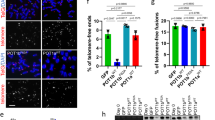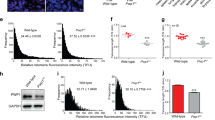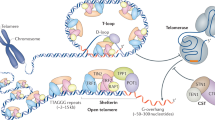Abstract
Telomeres are essential for maintaining cellular proliferative capacity and their loss has been implicated in ageing. A key regulator in telomere maintenance is the telomeric protein TRF1, which was also identified as Pin2 in a screen for Pin1. Pin1 is a unique prolyl isomerase that regulates protein conformation and function after phosphorylation. However, little is known about the role of Pin1 in telomere regulation or the modulation of TRF1 by upstream signals. Here we identify TRF1 as a major conserved substrate for Pin1 during telomere maintenance and ageing. Pin1 inhibition renders TRF1 resistant to protein degradation, enhances TRF1 binding to telomeres, and leads to gradual telomere loss in human cells and in mice. Pin1-deficient mice also show widespread premature ageing phenotypes within just one generation, similar to those in telomerase-deficient mice after 4–5 consecutive generations. Thus, Pin1 is an essential regulator of TRF1 stability, telomere maintenance and ageing.
This is a preview of subscription content, access via your institution
Access options
Subscribe to this journal
Receive 12 print issues and online access
$209.00 per year
only $17.42 per issue
Buy this article
- Purchase on Springer Link
- Instant access to full article PDF
Prices may be subject to local taxes which are calculated during checkout





Similar content being viewed by others
References
Blackburn, E.H. Switching and signaling at the telomere. Cell 106, 661–673. (2001).
Rodier, F., Kim, S.H., Nijjar, T., Yaswen, P. & Campisi, J. Cancer and aging: the importance of telomeres in genome maintenance. Int. J. Biochem. Cell Biol. 37, 977–990 (2005).
Blasco, M.A. Telomere length, stem cells and aging. Nature Chem. Biol. 3, 640–649 (2007).
Blasco, M.A. et al. Telomere shortening and tumor formation by mouse cells lacking telomerase RNA. Cell 91, 25–34. (1997).
Lee, H.W. et al. Essential role of mouse telomerase in highly proliferative organs. Nature 392, 569–574 (1998).
Chong, L. et al. A human telomeric protein. Science 270, 1663–1667 (1995).
van Steensel, B. & de Lange, T. Control of telomere length by the human telomeric protein Trf1. Nature 385, 740–743 (1997).
de Lange, T. Shelterin: the protein complex that shapes and safeguards human telomeres. Genes Dev. 19, 2100–2110 (2005).
Smith, S., Giriat, I., Schmitt, A. & de Lange, T. Tankyrase, a poly(ADP-ribose) polymerase at human telomeres. Science 282, 1484–1487. (1998).
Kim, S.H., Kaminker, P. & Campisi, J. TIN2, a new regulator of telomere length in human cells. Nature Genet. 23, 405–412. (1999).
Zhou, X.Z. & Lu, K.P. The Pin2/TRF1-interacting protein PinX1 is a potent telomerase inhibitor. Cell 107, 347–359 (2001).
Lee, T.H., Perrem, K., Harper, J.W., Lu, K.P. & Zhou, X.Z. F-box protein Fbx4 targets Pin2/TRF1 for ubiquitin-mediated degradation and regulates telomere maintenance. J. Biol. Chem. 281, 759–768 (2006).
Chang, W., Dynek, J.N. & Smith, S. TRF1 is degraded by ubiquitin-mediated proteolysis after release from telomeres. Genes Dev. 17, 1328–1333 (2003).
Lu, K.P., Hanes, S.D. & Hunter, T. A human peptidyl-prolyl isomerase essential for regulation of mitosis. Nature 380, 544–547 (1996).
Shen, M., Haggblom, C., Vogt, M., Hunter, T. & Lu, K.P. Characterization and cell cycle regulation of related human telomeric proteins Pin2 and TRF1 suggest a role in mitosis. Proc. Natl Acad. Sci. USA 94, 13618–13623 (1997).
Yaffe, M.B. et al. Sequence-specific and phosphorylation-dependent proline isomerization: A potential mitotic regulatory mechanism. Science 278, 1957–1960 (1997).
Shen, M., Stukenberg, P.T., Kirschner, M.W. & Lu, K.P. The essential mitotic peptidyl-prolyl isomerase Pin1 binds and regulates mitosis-specific phosphoproteins. Genes Dev. 12, 706–720 (1998).
Lu, P.J., Wulf, G., Zhou, X.Z., Davies, P. & Lu, K.P. The prolyl isomerase Pin1 restores the function of Alzheimer-associated phosphorylated tau protein. Nature 399, 784–788 (1999).
Lu, P.J., Zhou, X.Z., Shen, M. & Lu, K.P. A function of WW domains as phosphoserine- or phosphothreonine-binding modules. Science 283, 1325–1328 (1999).
Liou, Y.C. et al. Loss of Pin1 function in the mouse causes phenotypes resembling cyclin D1-null phenotypes. Proc. Natl Acad. Sci. USA 99, 1335–1340 (2002).
Zheng, H. et al. The prolyl isomerase Pin1 is a regulator of p53 in genotoxic response. Nature 419, 849–853 (2002).
Liou, Y.-C. et al. Role of the prolyl isomerase Pin1 in protecting against age-dependent neurodegeneration. Nature 424, 556–561 (2003).
Lu, K.P. & Zhou, X.Z. The prolyl isomerase Pin1: a pivotal new twist in phosphorylation signalling and human disease. Nature Rev. Mol. Cell Biol. 8, 904–916 (2007).
Ryo, A. et al. Pin1 is an E2F target gene essential for the Neu/Ras-induced transformation of mammary epithelial cells. Mol. Cell. Biol. 22, 5281–5295 (2002).
Atchison, F.W., Capel, B. & Means, A.R. Pin1 regulates the timing of mammalian primordial germ cell proliferation. Development 130, 3579–3586. (2003).
Pastorino, L. et al. The prolyl isomerase Pin1 regulates amyloid precursor protein processing and amyloid-β production. Nature 440, 528–534 (2006).
Kishi, S., Wulf, G., Nakamura, M. & Lu, K.P. Telomeric protein Pin2/TRF1 induces mitotic entry and apoptosis in cells containing short telomeres and is down-regulated in breast tumors. Oncogene 20, 1497–1508 (2001).
Nakamura, M. et al. A specific interaction between the telomeric protein Pin2/TRF1 and the mitotic spindle. Curr. Biol. 11, 1512–1516 (2001).
Zhou, X.Z., Perrem, K. & Lu, K.P. Role of Pin2/TRF1 in telomere maintenance and cell cycle control. J. Cell. Biochem. 89, 19–37 (2003).
Lim, J. et al. Pin1 has opposite effects on wild-type and P301L tau stability and tauopathy. J. Clin. Invest. 118, 1877–1889 (2008).
Cristofari, G. & Lingner, J. Telomere length homeostasis requires that telomerase levels are limiting. EMBO J. 25, 565–574 (2006).
Milyavsky, M. et al. Prolonged culture of telomerase-immortalized human fibroblasts leads to a premalignant phenotype. Cancer Res. 63, 7147–7157 (2003).
Bryan, T.M., Englezou, A., Gupta, J., Bacchetti, S. & Reddel, R.R. Telomere elongation in immortal human cells without detectable telomerase activity. EMBO J. 14, 4240–4248 (1995).
Pinton, P. et al. Protein kinase C β and prolyl isomerase 1 regulate mitochondrial effects of the life-span determinant p66Shc. Science 315, 659–663 (2007).
Sultana, R. et al. Oxidative modification and down-regulation of Pin1 in Alzheimer's disease hippocampus: A redox proteomics analysis. Neurobiol. Aging 27, 918–925 (2006).
Panossian, L.A. et al. Telomere shortening in T cells correlates with Alzheimer's disease status. Neurobiol. Aging 24, 77–84 (2003).
Loayza, D. & De Lange, T. POT1 as a terminal transducer of TRF1 telomere length control. Nature 423, 1013–1018 (2003).
Rufer, N., Dragowska, W., Thornbury, G., Roosnek, E. & Lansdorp, P.M. Telomere length dynamics in human lymphocyte subpopulations measured by flow cytometry. Nature Biotechnol. 16, 743–747. (1998).
Chiang, Y.J. et al. Expression of telomerase RNA template, but not telomerase reverse transcriptase, is limiting for telomere length maintenance in vivo. Mol. Cell Biol. 24, 7024–7031 (2004).
Hemann, M.T. & Greider, C.W. G-strand overhangs on telomeres in telomerase-deficient mouse cells. Nucleic Acids Res. 27, 3964–3969 (1999).
Acknowledgements
We are grateful to J. Frangioni and R. Bronson for assistance in determining bone-related and ageing phenotypes in Pin1 knockout mice, and W. Hahn for TERT and TER expression vectors. J. L. is a Human Frontiers Science Program Fellow, C.Y.S. is a Predoctoral Fellow of the DOD Breast Cancer Research Program and L. P. is a recipient of a Mentored Research Scientist Development Award from the NIH (K01). The work was supported by NIH grants to X. Z. Z. (R01CA122434) and K.P.L. (R01GM058556 and AG017870).
Author information
Authors and Affiliations
Corresponding authors
Ethics declarations
Competing interests
The authors declare no competing financial interests.
Supplementary information
Supplementary Information
Supplementary Information (PDF 1687 kb)
Rights and permissions
About this article
Cite this article
Lee, T., Tun-Kyi, A., Shi, R. et al. Essential role of Pin1 in the regulation of TRF1 stability and telomere maintenance. Nat Cell Biol 11, 97–105 (2009). https://doi.org/10.1038/ncb1818
Received:
Accepted:
Published:
Issue Date:
DOI: https://doi.org/10.1038/ncb1818
This article is cited by
-
Thymidine nucleotide metabolism controls human telomere length
Nature Genetics (2023)
-
Expression, Purification, Structural and Functional Characterization of Recombinant Human Parvulin 17
Molecular Biotechnology (2023)
-
SMARCE1 promotes neuroblastoma tumorigenesis through assisting MYCN-mediated transcriptional activation
Oncogene (2022)
-
Cancer and Alzheimer’s disease inverse relationship: an age-associated diverging derailment of shared pathways
Molecular Psychiatry (2021)
-
Sulfopin is a covalent inhibitor of Pin1 that blocks Myc-driven tumors in vivo
Nature Chemical Biology (2021)



